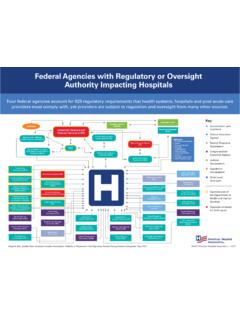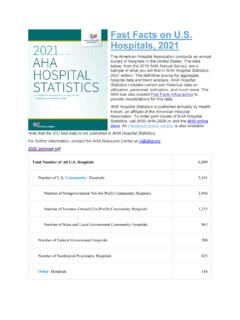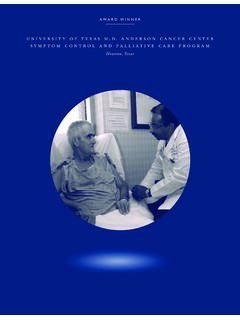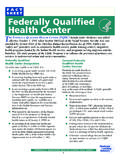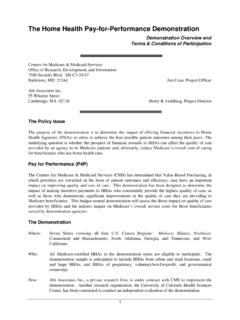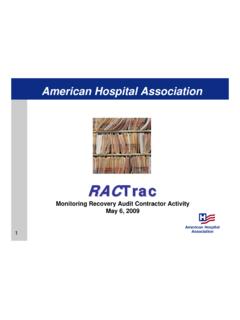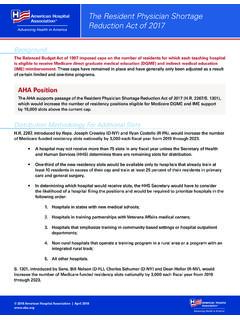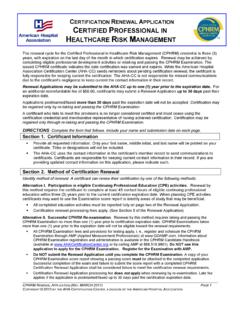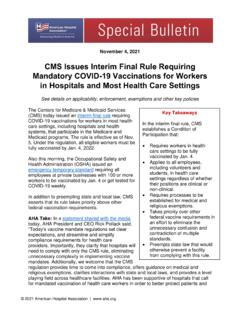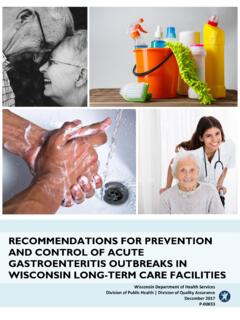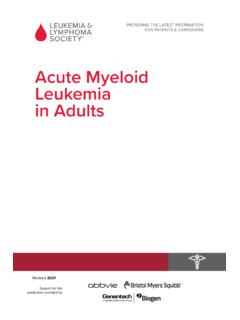Transcription of Ligature-risk requirements
1 30 // NOVEMBER / DECEMBER 2018 SAFETYIMAGE COURTESY OF ASHEBY CHAD BEEBE, AIA, CHFM, CFPS, CBO, FASHEL igature-risk requirementsSeparating fact from fiction in suicide preventionFew events in health care facilities are as catastrophic and preventable as a patient suicide. Yet data indicate that suicide incidents are a serious problem, which suggests that hospitals must do a better job not only of identifying and monitoring patients at risk but removing the means to accomplish suicide in the physical facts are sobering: The suicide rate has increased more than 25 percent nationwide from 1999 to 2016, per a recent Centers for Disease Control and Prevention (CDC) report, which also found that 54 per-cent of those who died by suicide in that period did not suffer from a mental health condition. According to the CDC, suicide is now the 10th leading cause of death in the United States, taking more than 40,000 lives a year.
2 The most recent data published by the National Violent Death Reporting System (NVDRS) reveals that, in 2015, 83 suicides occurred in medical facilities. The vast majority of these inpatient suicides have resulted from hanging, most commonly in a bathroom or bedroom and often using a door or its handle or hinge; a head, handle, bar or door in the shower; a ceiling or sink pipe; or another type of fixture as the ligature fixation point. Logic dictates that eliminating these and other liga-ture risks from the environment of a patient with suicidal ideation is necessary. Standards and requirements by accrediting organizations mandate as the truth is, many health care organizations are misinterpreting the requirements for reducing ligature risk. Others mistakenly believe that new ligature-resis-tance rules have been put into effect, which is not accu-rate.
3 And plenty suffer from the misconception that elimi-nating ligature points is the only effective solution. In reality, decreasing ligature risks isn t practical in many hospitals. Additionally, it s not the best or sole option. The key to more successfully preventing sui-cides is for health care organizations to change their way of thinking about this issue. They need to realize that ligature resistance is secondary to a more import-ant priority: providing continuous one-to-one (1:1) observation of any patient with suicidal eyes have itContinuous 1:1 observation of these at-risk patients should be considered the first priority of suicide prevention in hospitals. That s because constant visual monitoring especially observations condu-cive to 360-degree viewings by a paid sitter in the room assigned to one patient provides little room for error.
4 Removal of objects that can inflict harm is also In situations where 1:1 observation is not possible, ligature-resistance steps need to be taken NOVEMBER / DECEMBER 2018 // 31 PATIENT SAFETY important, but there s no substitute for human eyeballs and the ability to immediately intervene when suicidal thoughts change to a suicidal Centers for Medicare & Medicaid Services (CMS) attempted to clarify this point in December 2017 by publishing revised interpretive guidelines regarding the assessment of ligature risks. That publication stated: Psychiatric patients requiring medical care in a non-psychiatric setting (medical inpatient units, ED, ICU, etc.) must be protected when demonstrating suicidal ideation or harm to others. The protection would be that of utilizing safety measures such as 1:1 monitoring with continuous visual observation, removal of sharp objects from the room/area, or removal of equipment that can be used as a weapon.
5 Put another way, if a person in the hospital can watch one assigned at-risk patient unceasingly, the only hazards that need to be removed are anything that could quickly be used to inflict harm. That means taking away items like glass flower vases, pens and sharp eating utensils. It doesn t require major changes to the physical environ-ment like eliminating grab bars, sink drain pipes or door hinges, or installing over-the-door sensors. There s no pragmatic reason to take these steps, because an assigned sitter watching closely could easily intercede before a patient could achieve situations where this level of observation is not possible (as is often the case in psychiatric hospitals), ligature-resistance steps need to be taken instead. But if the facility is able to provide continuous 1:1 observation, removing ligature risks is not required, contrary to what many in the field are saying.
6 The bottom line: Hospitals must do one or the other, but not necessarily both. There are exceptions to this rule, however. Some states have privacy laws, for example, where patients are not allowed to be accompanied in the bathroom; in these instances, removing ligature risks is necessitated [see sidebar at right]. Another myth that needs to be addressed is that new ligature-resistance rules recently have been introduced. Technically, this isn t true. What s relatively new is that periodic visual observations of patients kept in a pro-tective environment are no longer permitted by CMS. The health care field has learned the hard way that five-, 10-, or 15-minute checks on at-risk patients are woefully inadequate at preventing suicide. The CMS requirement of 1:1 monitoring with continuous visual observation replaces this s easy to see how that recent CMS edict has creat-ed confusion in the field.
7 After all, it begs the question: If continuous 1:1 monitoring is in place, is ligature resistance still required? Rest assured that the answer is no for now, anyway. CMS states that it s working on drafting comprehensive Ligature-risk interpretive guidance that should be released steps to takeTo help their facilities reduce patient-suicide risks, it s important for health care organizations to heed indus-try-accepted guidelines and best practices. Facility IMAGE BY GETTY IMAGESThe American Society for Health care Engineering advises a three-step strat-egy for managing ligature risks and preventing patient self-harm in general acute care or emergency departments (these steps are not applicable in psychiatric units):1 IDENTIFY Identify patients who are currently at risk for intentional harm to themselves or others.
8 (Steps 2 and 3 only need to be taken with patients who are identified as a risk.)2 OBSERVEP rovide 1:1 monitoring of at-risk patients with continuous visual observation. The person observ-ing the patient needs to be able to intervene immediately. Video observation is not appropri-ate since the video monitoring process cannot provide immediate intervention. Note that some states require privacy in certain situations, such as when the patient is using the bathroom. In these instances, since 1:1 observation is not possible, the bathroom used by the patient must be ligature-resistant. Converting a bathroom to a ligature-resistant environment can affect fire and life-safety regulations and Americans with Disabil-ities Act-compliance issues. Organizations should conduct a careful review of the rules and regula-tions that apply to their specific REMOVE In any instances where 1:1 continuous observa-tion is not feasible, hospitals must remove or clin-ically mitigate all environmental risks.
9 Loose items should be removed from the patient area. Fixtures installed in the room do not need to be removed; however, patient access to certain areas may need to be restricted to prevent patients from reaching items that they could use for self-harm. ASHE s three-step, Ligature-risk guidance32 // NOVEMBER / DECEMBER 2018 SAFETY // Ligature-risk requirements Use drop ceilings in common patient care areas and hallways, provided that all aspects of the hallway are fully visible to staff and there are no objects that patients could easily use to ascend to the drop ceiling, remove a panel and gain access to Ligature-risk points above the drop ceiling. Determine the optimal type of patient bed utilized to meet both medical and psychiatric needs. Carefully assess and balance medical needs and the patients risk for suicide.
10 For patients who require medical beds with ligature points, appro-priate mitigation plans and safety precau-tions must be in place. Standard toilet seats with a hinged seat and lid shouldn t be noted on a risk assessment or cited during surveys. They are not a significant risk for suicide attempts or self-harm. Organizations shouldn t be required to install risk-mitigation devices to reduce the likelihood that the top of a corridor door will be used as a ligature-attachment DEPARTMENTS. When it comes to EDs, note that they don t need to meet the same standards as inpatient psy-chiatric units to be regarded as ligature- resistant settings. ED patients commonly need equipment and devices to treat and monitor their medical issues. Consequently, making the ED environment completely ligature-resistant is impossible.
